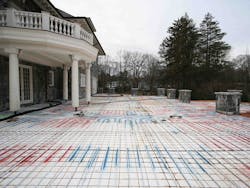A tale of two zones
By Lisa Murton Beets
Snowmelt jobs aren’t that uncommon anymore. But how often do you see a system that has to take care of two zones with completely different thermal characteristics?
That’s the opportunity Advanced Radiant Design, Stone Ridge, N.Y., had when it was contracted by Francis Development to design and install a snowmelt system for an expansive property located in Greenwich, Conn. In total, the system would have to accommodate for 8,500-sq.ft., including a stone patio with living space underneath, as well as a long, winding driveway.
The house itself was built several years ago and had served as a Designer’s Showcase home. After the current owners purchased it, they hired Francis Development to renovate it. Today, the owners live in Vail and rent the home.
“They have a snowmelt system at their Vail home, and they wanted snowmelt for this house as well,” says general contractor Frank Usowski.
Snowmelt for this project was not just “something nice to have,” though. There’s really nowhere to push plowed snow, so there was also a logistical difficulty to address. And the renovation served as the perfect time to solve the problem.
Usowski reached out to Advanced Radiant Design. “John Abularrage is the only guy who does my radiant,” he says. “There are a lot of firms out there, but John’s company has it down to a science…they are completely dialed in on radiant.”
Abularrage, the owner of Advanced Radiant Design, had to design this project to take the two different surfaces into account. The first zone, encompassing 3,500-sq.ft., is the suspended, stone-covered patio. The second zone is the 5,000-sq.-ft. asphalt driveway.
Because there was no blueprint for the project, Abularrage had to survey the irregular driveway in order to draw the tubing layout. “This was an iterative process of surveying, drawing, verifying and refining,” he says. “The design incorporated extension/contraction loops in the irregular areas, so that any inconsistencies could be accommodated. The loop lengths were all calculated in the drawing process to ensure the accuracy of loop lengths during installation.”
The stoned-covered patio is unique in that it also serves as the ceiling for an underground garage and living space. According to Usowski, the ceiling over that space was having water leakage issues, so it was completely torn out and rebuilt. Advanced Radiant Design then had to run the snowmelt tubing down through the new patio (aka the garage ceiling) barrier consisting of concrete, wire mesh, rubber decking, insulation and concrete planking.
The second zone, the asphalt driveway, has tubing embedded in Item 4 (crushed rock/stone dust) subbase. Two manifolds were used for the driveway. Each was remotely located in a concrete vault. The supply and return mains to the remote manifold consist of buried, insulated 50mm Uponor PEX.
The patio area is also serviced by two manifolds, mounted to the ceiling of the garage, below the patio. Both zones feature UponorHePex tubing. Abularrage estimates he used about 15,000-ft. of tubing total.
The boilers are staged, rotated, and reset by a Tekmar 268 staging control.
Mixing/Zoning System
The control system is a Tekmar 664, two-zone automatic snow control with a four-way mixing valve and Tekmar 090 automatic snow sensor. The patio zone has the automatic snow sensor, and the driveway zone has the temperature sensor.
To get the programmed idle and melt surface temperatures correlated accurately and balanced, Abularrage’s team performed multiple correlations of those temperatures compared to actual surface temperatures using an infrared thermometer.
“It helped us learn a lot about how two different surfaces react under the exact same conditions,” he says. “By directly comparing surface temperatures during idle mode, we were able to clearly see that the water temperature for the asphalt driveway needed to be a solid 10°F higher than the stone-covered patio in order to maintain the same surface temperature during idle times.
“We were also able to better understand the ‘thermal lag’ of the asphalt area, which then required two hours of additional melting time to accomplish the same snow-free and dry surface,” he continues. “Proper adjustment and balancing of a snowmelt system is critical if you’re going to fulfill the client’s expectations while also maintaining the lowest possible energy consumption.”
In the final analysis, the system is operating spectacularly. “It’s performing to the expectations of the home-owners and has not only provided convenience but also safety,” Abularrage says. “They only wished they would have installed snowmelt under the remaining portions of the driveway, as well.”
Lisa Murton Beets is a Cleveland-based freelance writer and frequent contributor to Radiant Living.

